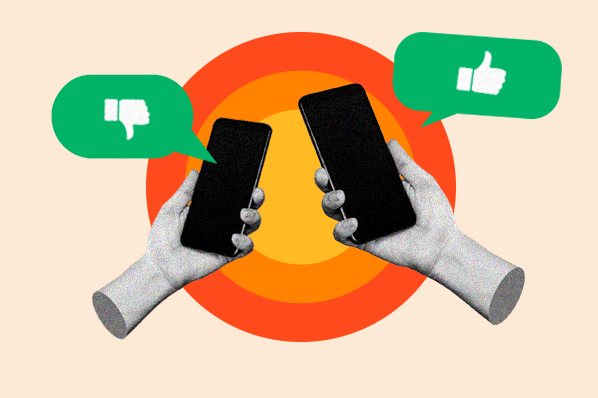Text message campaigns aren’t just trendy — they work. Really well. SMS marketing conversion rates fall between 21% and 40% across different industries.
Let’s get into why.
Table of Contents
- What is an SMS marketing app?
- The Benefits of Text Message Marketing
- The Challenges of Using Text Message Marketing
- How to Choose the Right Text Message Marketing Service
- The 6 Best SMS Marketing Apps
What is an SMS marketing app?
An SMS marketing app is a chat application or platform that enables users to text message and connect with each other through their computers or mobile devices. Think Facebook Messenger, WhatsApp, WeChat, or Slack (just to name a few).
The Benefits of Text Message Marketing
According to a 2023 market analysis, the number of mobile messenger app users will grow to nearly seven billion worldwide by 2030. If this projection holds, it would mark a 92% increase in less than a decade.
In a device-dependent age, where consumers are bombarded with endless information, distraction, and content, it seems intuitive that time is one of our most valuable resources.
And like all resources, time is something people don't like to waste.
That’s why you still need SMS marketing.
Here are the standout reasons.
Speed
Messaging apps allow you to connect and engage your customers in real time. In some cases, messaging apps even help you respond to your potential leads, prospects, and customers instantaneously.
The speed of this communication channel will almost always outpace that seen on other channels, such as email or phone.
Familiarity
Messaging apps work so well for businesses because people already use them every day to talk with friends and family. There’s no learning curve — customers are comfortable with the format, which makes them more likely to engage.
Plus, people are used to GIFs and emojis, making conversations more fun and relatable. As a business, you can jump right in and use this opportunity to connect and build relationships with them.
Research shows that 73% of consumers think MMS is a great way for brands to show personality and stand out in their inbox. Plus, 52% say emojis make messages feel more relatable and engaging.
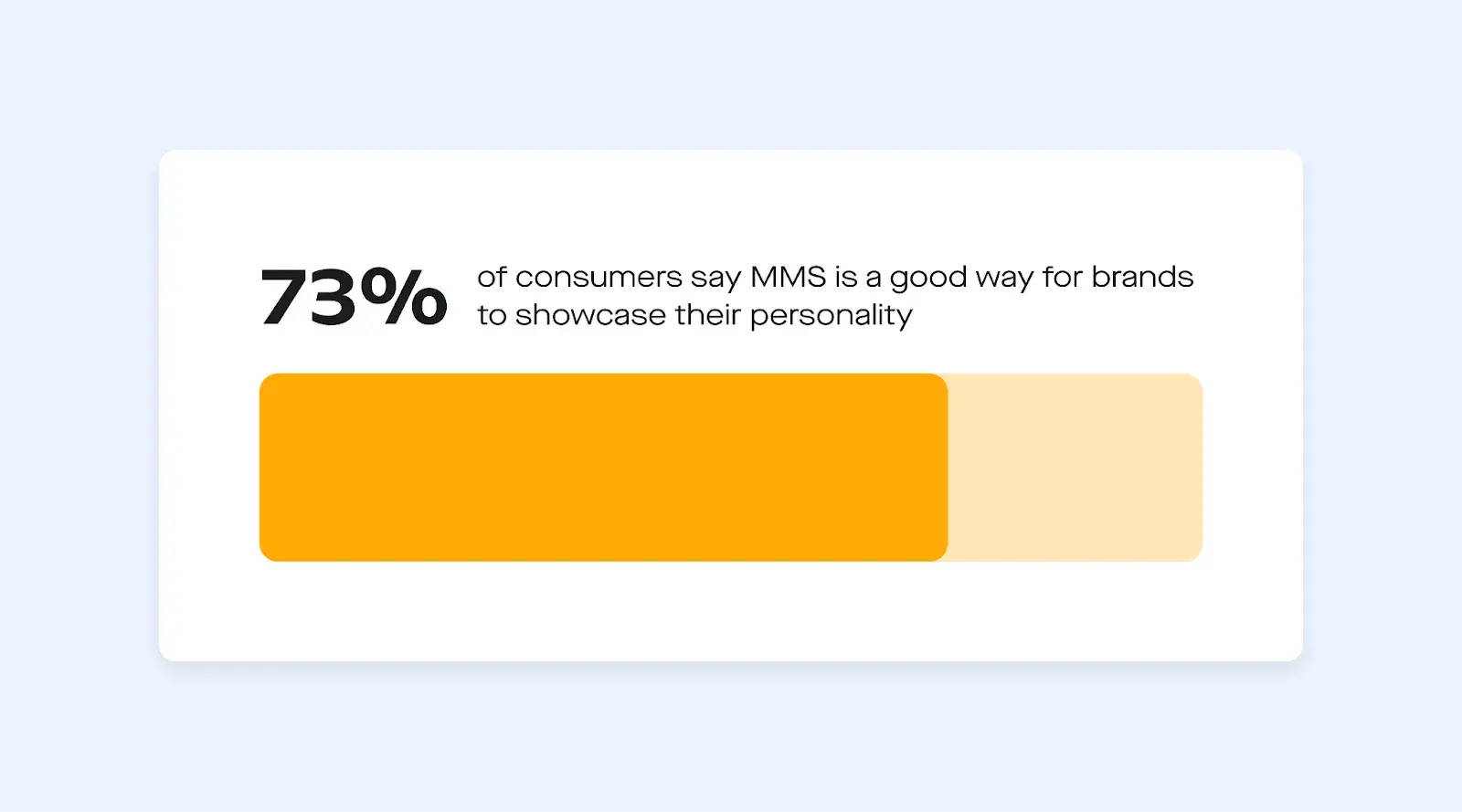
Convenience
Messaging apps can be seamlessly blended into your everyday workflow. You can reach out or answer an inquiry from any device, close the app, and return to whatever you were doing. Then, whenever the other party is available to respond, they will — and then you can take your turn.
The one-to-one nature of the channel is extremely convenient for both businesses and consumers, as it allows both parties to have complete context for the conversation and continue the thread as they see fit.
Customer Engagement
Businesses are increasingly turning to messaging apps for communication, driven by key factors like efficiency, compliance, and customer engagement.
Instant messaging helps teams move faster, and in today’s insanely fast-paced world, keeping up isn’t just a trend — it’s a must. Studies show that employees using messaging apps to communicate with each other see a 21% increase in productivity.
Another trend is encrypted messaging, especially popular on Facebook Messenger.
Encrypted messages keep conversations private by ensuring only the sender and recipient can read them. This prevents hacking, surveillance, and data leaks, making chats more secure for personal and business use. As privacy concerns grow, end-to-end encryption aligns with global regulations like GDPR and CCPA.
The Challenges of Using Text Message Marketing
Messaging apps enable you to communicate with your website visitors in real time, but it comes with a catch.
Budget
Free services will usually require that you show the messaging app‘s branding. You may also only have access to a limited number of features. With this in mind, it’s important to compare what each service offers in their pricing packages and how that fits your requirements as a company.
Management and Response Time
It can be frustrating when a company sets expectations and isn't able to live up to that promise. For this reason, you want to make sure you have the proper number of people responding to the messages.
If your team is multi-tasking, consider using automatic follow-up messages that set clear expectations about when the user will hear back. If you are using a messaging app and notice that the same questions or interactions keep popping up, consider investing in a simple chatbot.
We can see automated chats everywhere now — on Facebook, WhatsApp, and Viber. In fact, according to Tidio research, 45% of the businesses that use chatbots receive positive customer feedback after an interaction.
This can help delight visitors by offering quick responses to their FAQs and segmenting more sensitive or unique questions to the correct member of your team.
Keeping a Consistent Brand Voice
Gifs and emojis are great for quickly and informally communicating ideas or emotions. But brand voice and tone go beyond effective use of visuals or quippy copy.
Training your team members to chat in a manner that aligns with your company's vision, mission, and impact is key. This creates alignment between the copy on your website and the experience your team is providing through messaging. The same goes for if you choose to incorporate a chatbot into your messaging app to add a layer of automation.
Messaging apps bring you that much closer to creating delight in every conversation.
Choosing the Best Provider
Have you tried to list all the messaging apps recently? There are quite a few:
- Facebook Messenger
- Slack
- Discord
- Viber
- Line
- Snapchat
- Telegram
Each messaging app has its own demographic of users based on age, regions, and the range of in-app features.
Setting up messaging for your business takes time, money, and effort — especially in countries with multiple popular apps. Start small by testing a few options and be ready to remove ones that don’t deliver results.
Your buyer personas can guide your choice, but preferences aren’t always obvious. Experiment early to avoid overcommitting to a platform that doesn’t pay off.
Also, keep data protection in mind. Messaging lets you collect customer info naturally, but with laws like GDPR, make sure you know where data is stored and stay compliant.
How to Choose the Right Text Message Marketing Service
There are tons of options out there, but not all of them are worth your time (or money). After testing a few and checking what other users say, I put the list of what actually matters:
1. Know your goals.
First things first — figure out what you need. Are you sending promos, appointment reminders, or running two-way conversations? Knowing your purpose helps you pick the right tool.
Here’s what I suggest:
- Go with a tool that has a clean, intuitive dashboard, making it easy to set up and manage campaigns.
- Look for tools that allow you to automate messages and schedule them in advance.
- Make sure it integrates smoothly with your CRM, email marketing platform, or e-commerce system (depending on your needs).
- Choose a service that helps you manage opt-ins and stay compliant with texting laws (like TCPA).
- You need analytics features to assess the campaigns’ performance.
2. Pricing that you can afford.
Some services charge per text, while others have monthly plans. Think about how many messages you’ll send and pick what fits your budget.
If your volume fluctuates, look for flexible plans that let you adjust as needed. Also, check for hidden fees like setup costs or extra charges for premium features.

3. Pay attention to delivery rates and reliability.
If your texts don’t get delivered, they don’t matter.
Local gateways often have stronger connections with regional carriers, reducing the chances of messages being blocked or delayed. They can also help you comply with country-specific regulations, which is super important for a smooth delivery.
Below, for example, a user railed against Twilio’s poor SMS delivery rates, although the platform is popular.

4. Good customer support matters.
82% of service pros say customers expect their issues to be resolved immediately, with most wanting a solution in less than 3 hours. And honestly, I’m one of those customers too. If a company doesn’t help me as soon as possible, there’s a huge chance I’ll move on.
So, before choosing a provider, check user reviews to see how responsive they are when problems arise.
If a service has long response times or unhelpful support, it could disrupt your communication when you need it most, so it’s better to skip.
5. Stay compliant.
Text message marketing comes with strict regulations, and failing to follow them can lead to fines or even getting blocked by carriers. Different regions have different rules: TCPA in the U.S., GDPR in Europe, and CASL in Canada.
One key requirement is getting proper opt-ins. You can’t just text people out of nowhere — they need to explicitly agree to receive messages.
A good service will provide built-in tools for collecting and managing consent, like opt-in forms, double opt-in confirmation, and clear unsubscribe options.
Also, check if the provider automates compliance by handling things like message disclaimers, time restrictions (so you don’t send texts at 3 AM), and opt-out tracking.
If a platform leaves compliance entirely up to you, that’s risky. In that case, it’s better to use one that actively helps you follow the rules.
Looking to learn more about GDPR compliance and how that impacts your usage of apps like Facebook Messenger? Learn how with the HubSpot GDPR Playbook here.
6. Test before you commit.
Most services offer free trials or demos. Use them to see if the platform actually fits your needs before you lock in.
You can also reach out to someone in your LinkedIn network if you see they’re using a tool (that’s something I do a lot). It’s easier to trust someone you know.
But on the flip side, if text message marketing isn’t a big part of your strategy and you’re only using it occasionally, you might not need a specialized tool at all. Going with WhatsApp Business, which is free, can be a solid option.
For example, Mia Jozipović, content manager at Siterice.hr (part of FamilyCare Group), says they use WhatsApp Community to share daily tips and tricks with their care providers.
They treat it as a knowledge base basically. Every day, Mia manually posts one useful tip in the group. It’s not time-consuming, and it works perfectly for their needs — to keep their audience engaged.
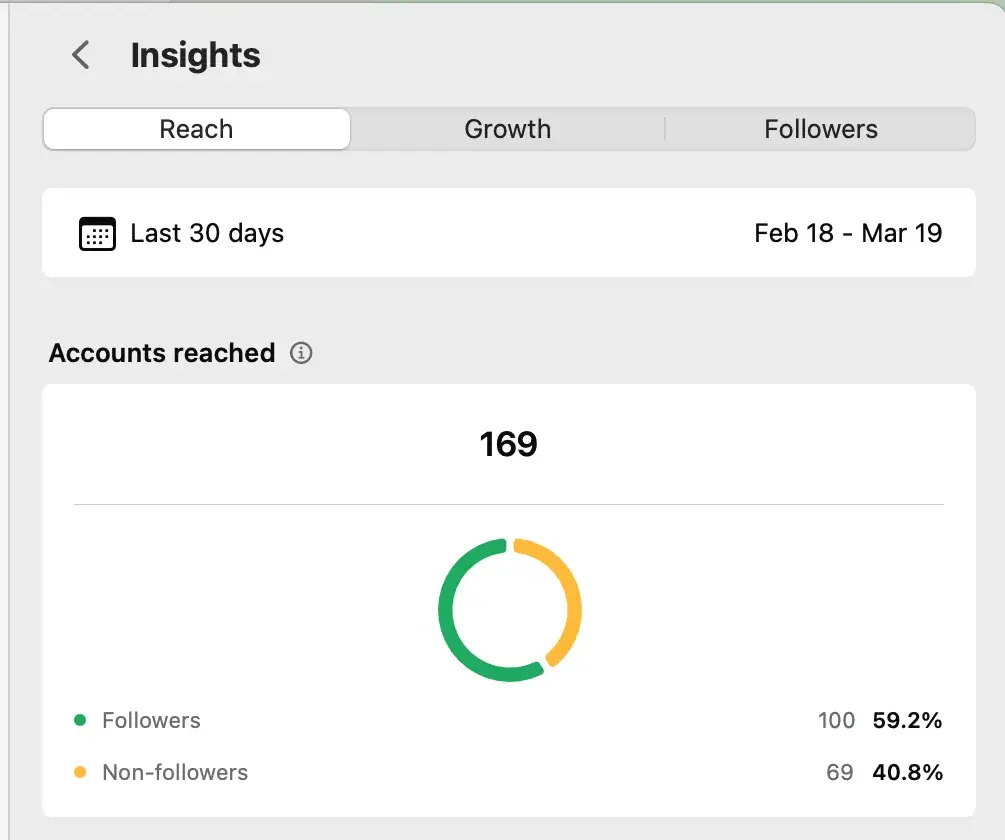
The 6 Best SMS Marketing Apps
Now, I’ll walk you through the best SMS marketing tools that can make your job easier — especially if this communication channel brings you a lot of value.
1. HubSpot SMS Marketing
HubSpot’s SMS Marketing feature lets businesses connect with customers through personalized, timely, and direct text messages. It integrates with HubSpot’s CRM for smooth communication and increased engagement.
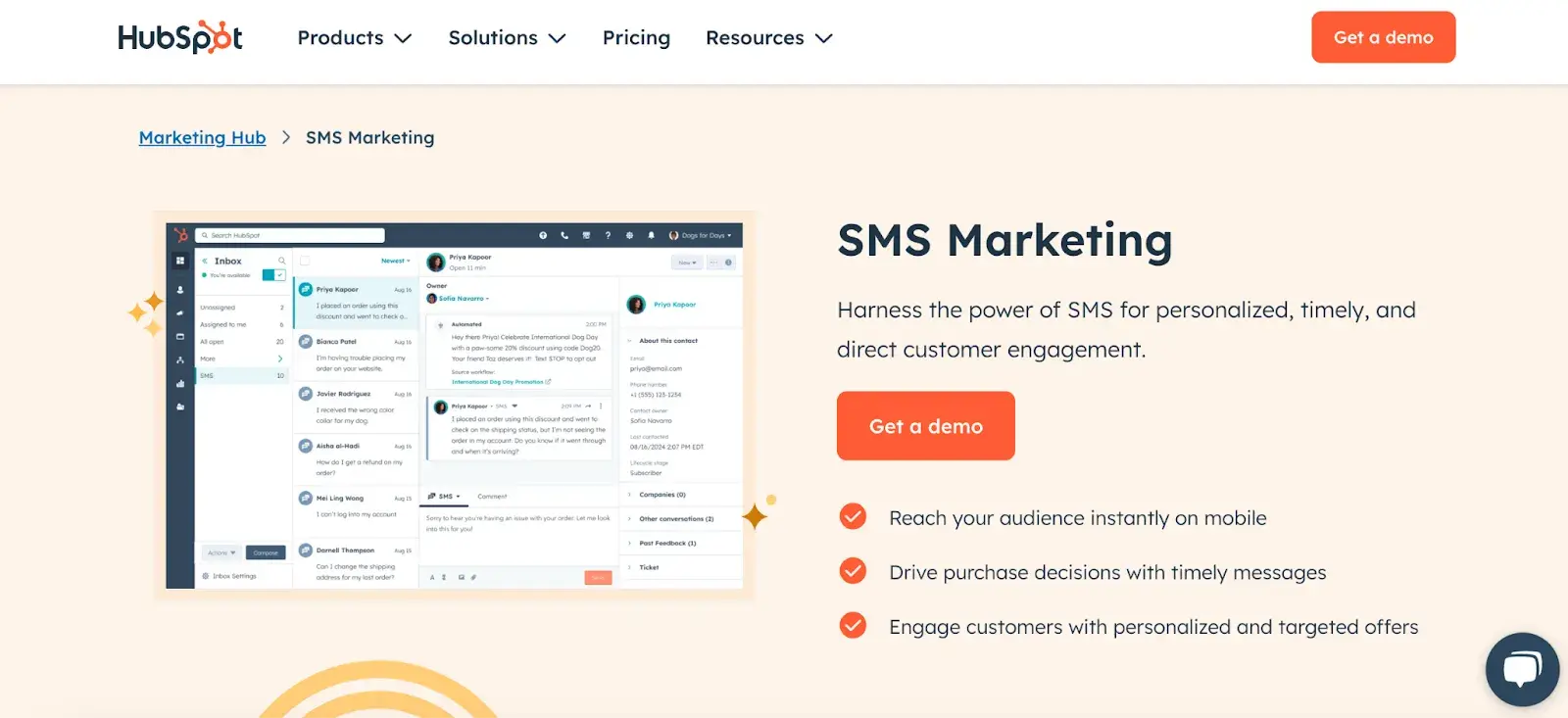
Features:
- Engage in two-way conversations with customers, allowing for real-time interactions.
- Send targeted messages, promotions, and reminders to drive customer engagement.
- Use personalization tokens and workflows to tailor messages and automate SMS campaigns.
- Schedule SMS messages to reach customers at the most effective times.
- Prevent messages from being sent outside of designated local time windows.
- Sync messages with HubSpot’s CRM to track interactions and customer engagement.
- Send large-scale SMS campaigns while maintaining personalization and compliance.
- Ensure messages meet carrier and legal requirements for SMS marketing.
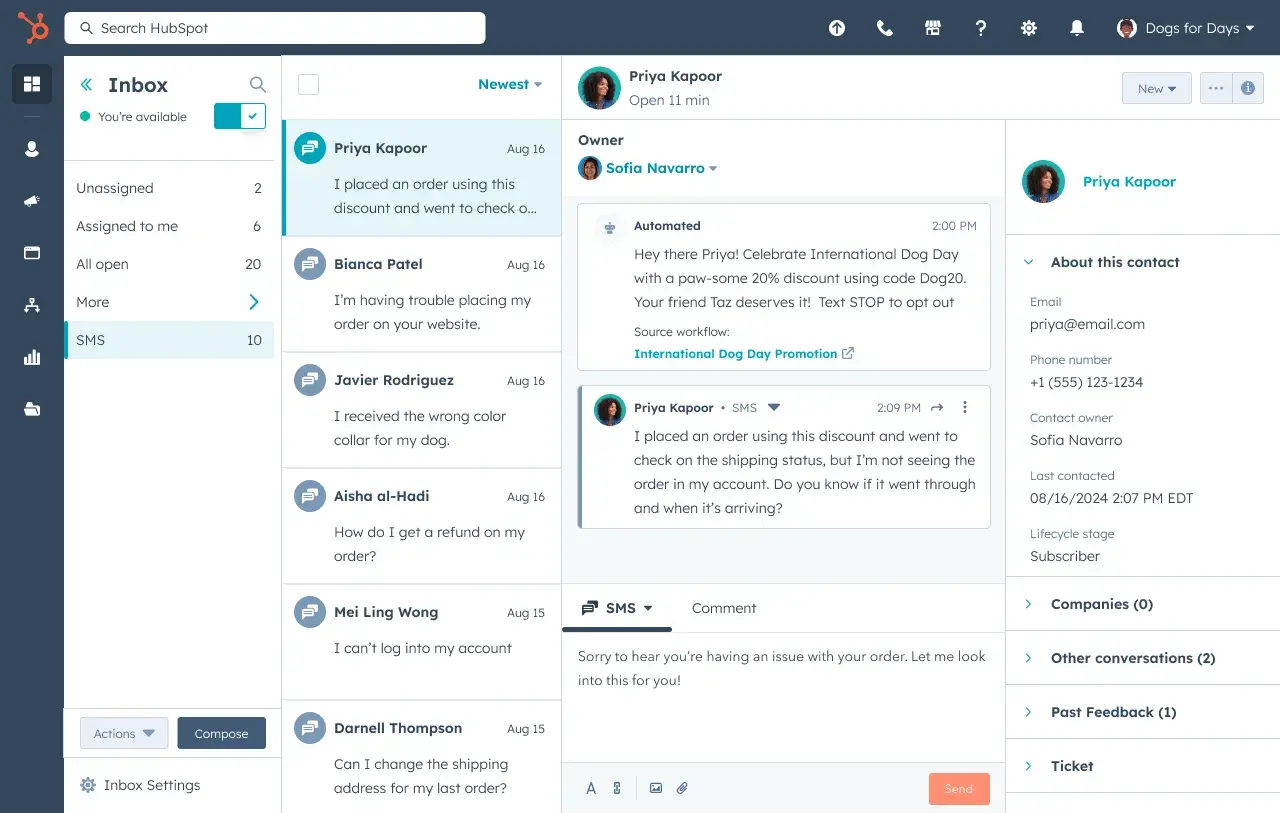
Pricing:
- Marketing SMS Add-on requires an additional purchase.
- SMS Shortcode Add-on is available for businesses needing high-volume messaging.
- Pricing varies based on usage and location, but you can test it out through a demo.
What I like: Direct engagement with automated, two-way messaging and CRM integration while respecting time zones with quiet hours management.
What I don’t like: If you‘re not a user of HubSpot Marketing’s Software, you can’t use the SMS service separately.
2. Twilio SMS Messaging
Twilio’s SMS messaging service allows you to send and receive text messages at scale using flexible APIs. It supports global reach, compliance tools, and automation to increase customer engagement.
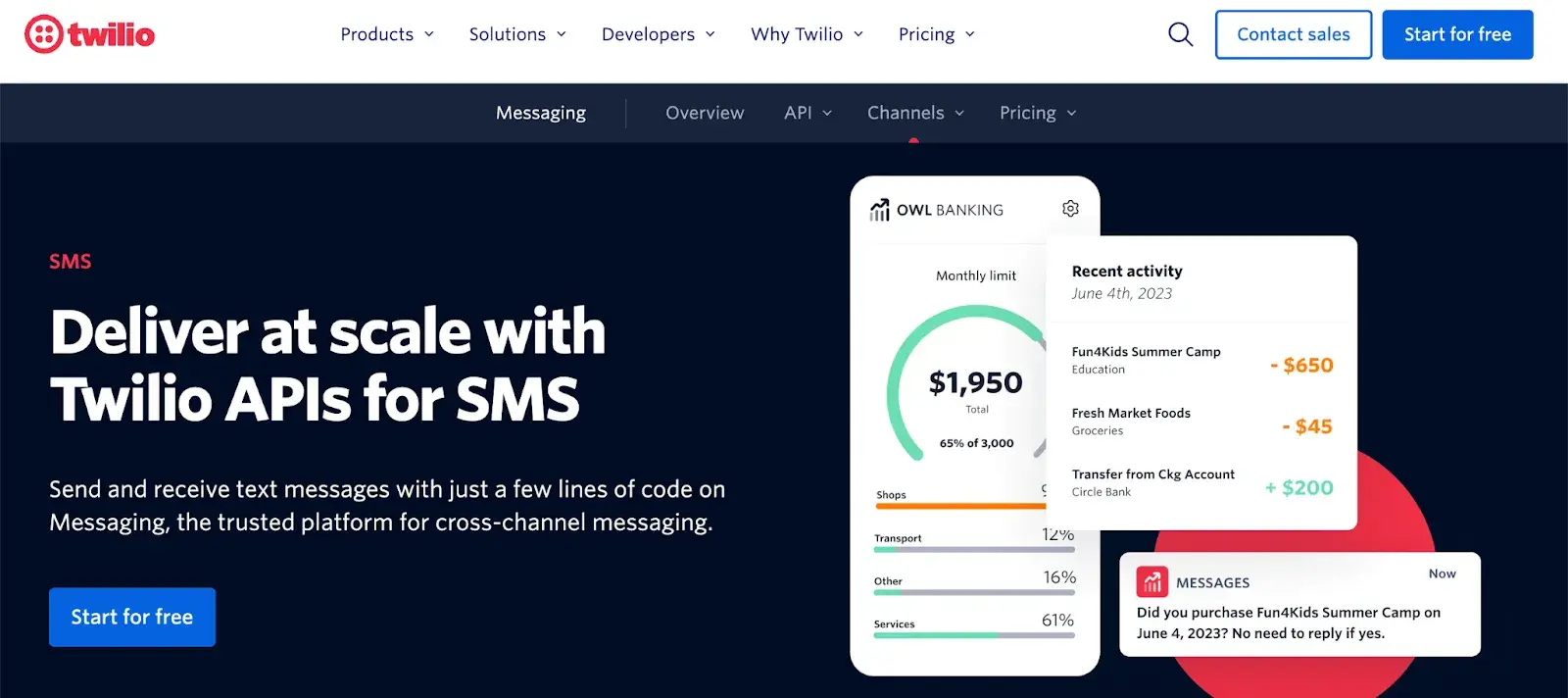
Features:
- Send transactional SMS, MMS, and WhatsApp messages with a single API.
- Enable two-way messaging across SMS, MMS, chat, and WhatsApp.
- Deliver messages reliably to over 180+ countries with localized senders and compliance tools.
- Schedule, personalize, and automate SMS workflows with built-in software.
- Monitor and troubleshoot message delivery and engagement.
- Use SMS for notifications, promotions, and verifications, or integrate with customer service chat.
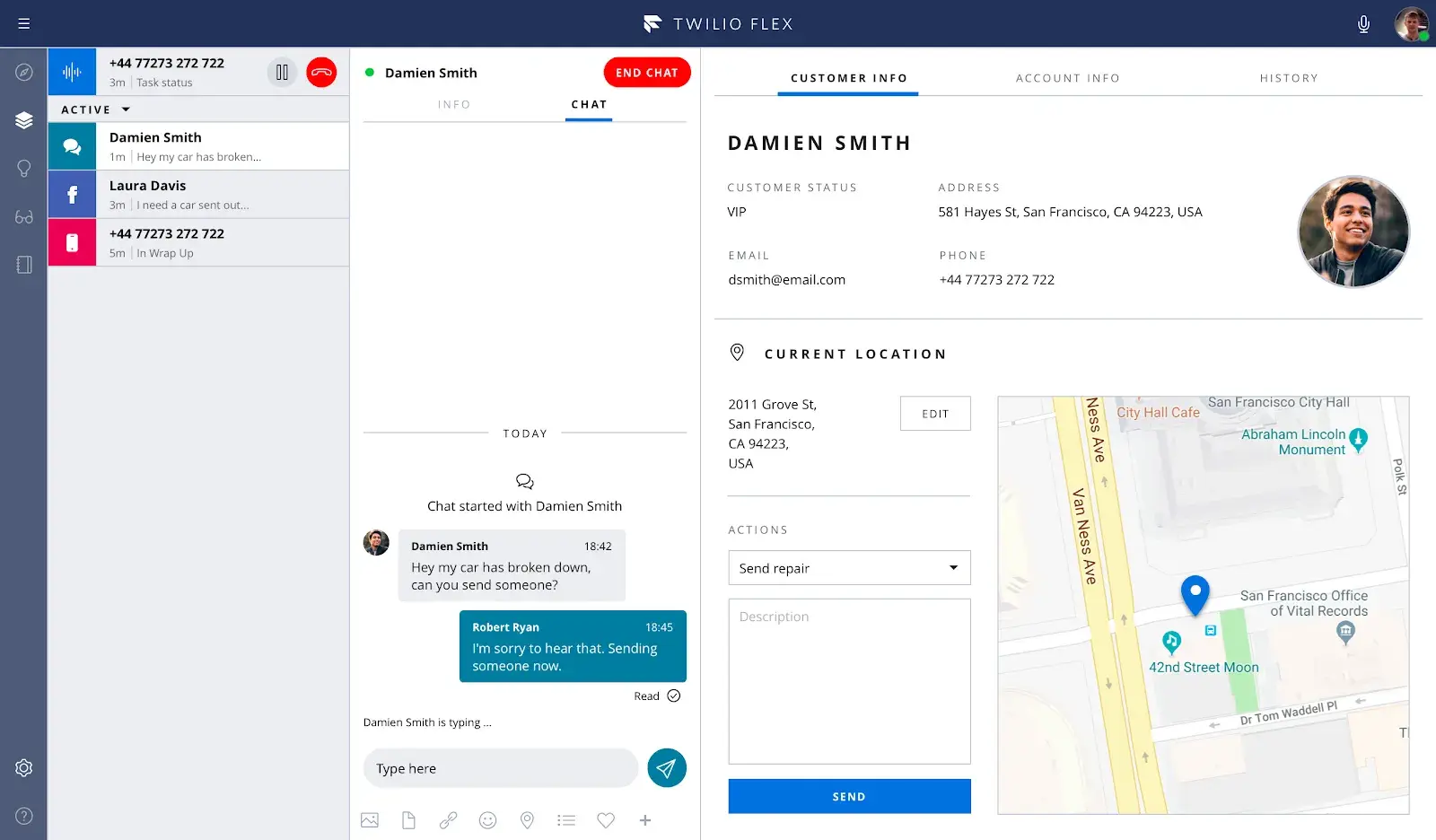
Pricing:
- Pay-as-you-go pricing with volume discounts.
- Long codes, toll-free numbers, and short codes are available with different pricing tiers.
- Additional fees may apply for carrier-specific costs and failed messages.
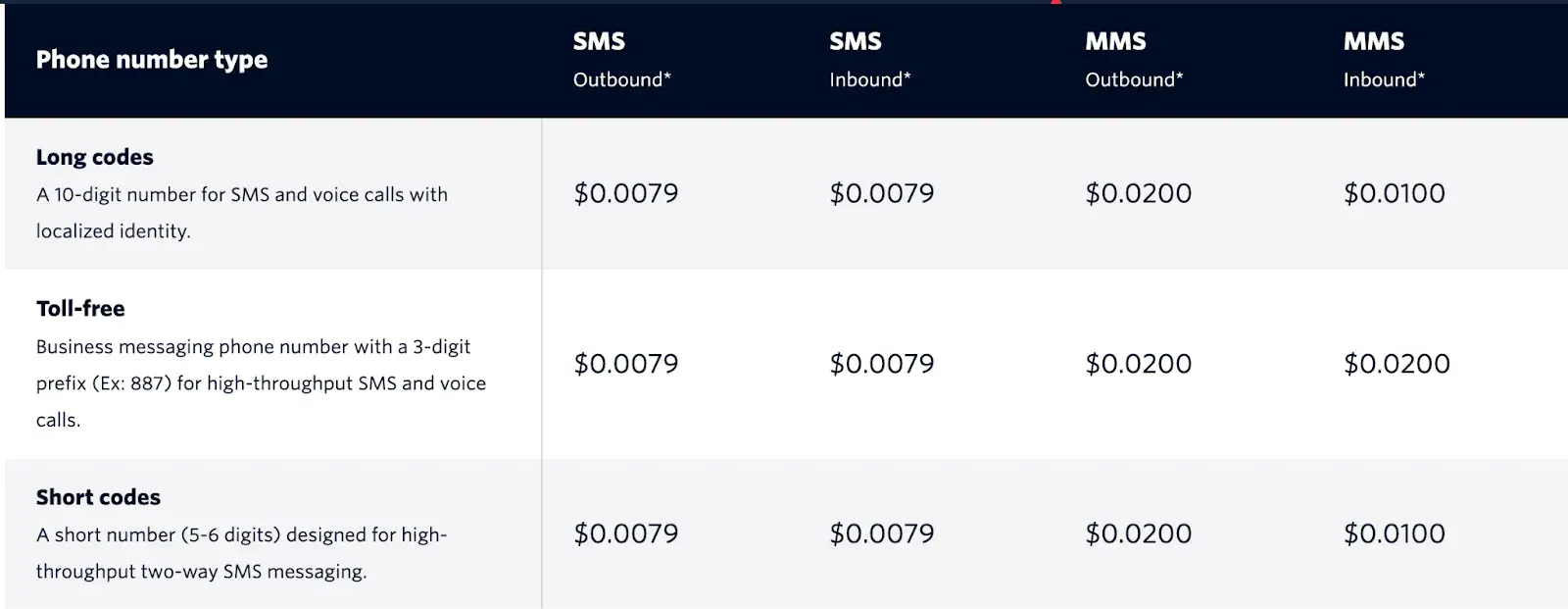
What I like: Flexibility with its APIs, global coverage, and automation features, making it great for scalable SMS campaigns.
What I don’t like: The setup process is overly complicated, poorly documented, and lacks real-time support, making it frustrating to integrate and use effectively.
3. Textmagic SMS Messaging
Textmagic is a cloud-based SMS service that helps businesses send notifications, alerts, and marketing messages. It offers an easy-to-use interface and API for automation while providing global reach.
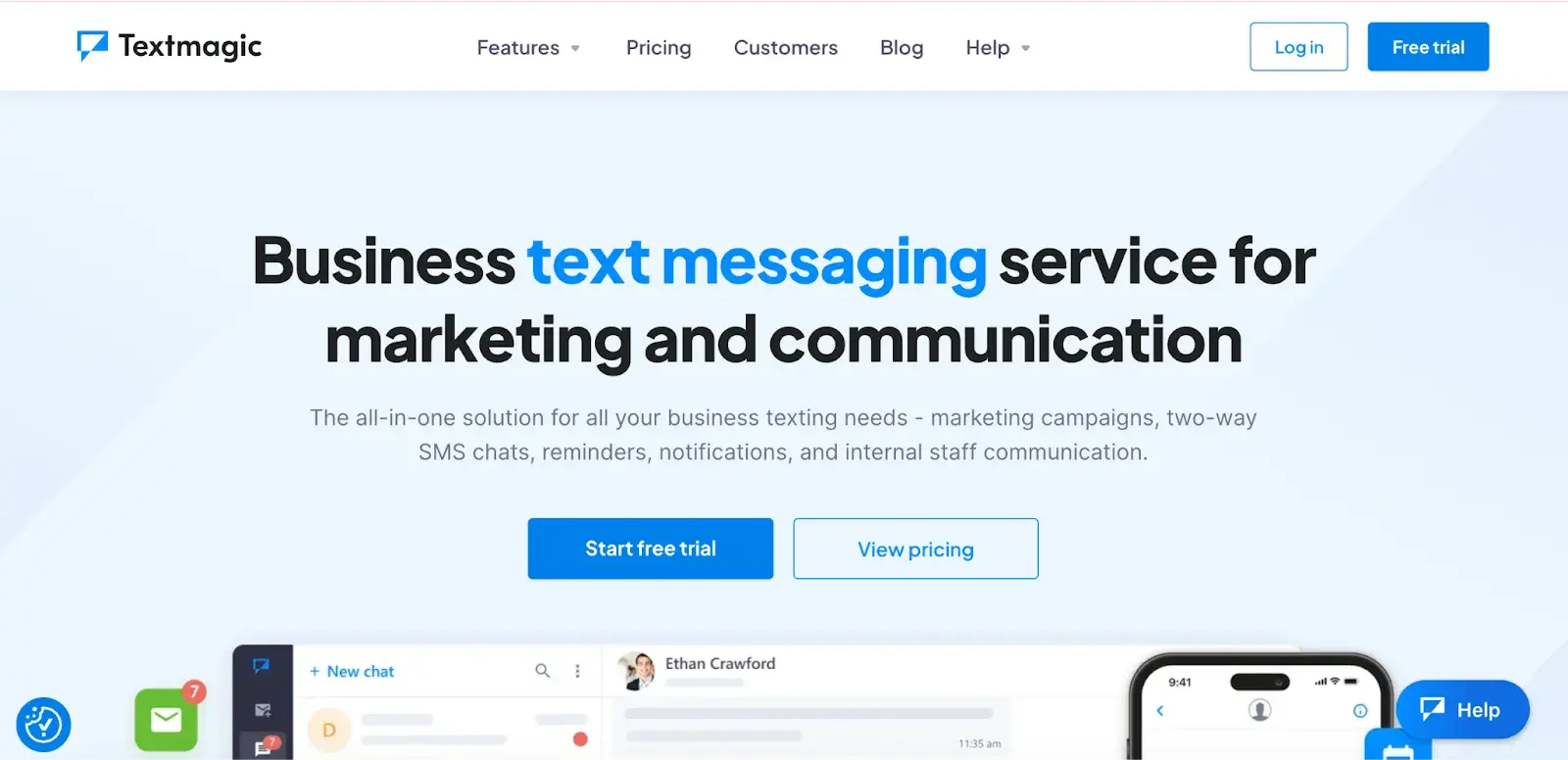
Features:
- Two-way SMS for real-time customer engagement.
- Bulk messaging for marketing campaigns and notifications.
- SMS automation via API, Zapier, and email-to-SMS integration.
- Message scheduling to reach customers at optimal times.
- Custom sender ID for brand recognition (where supported).
- Delivery reports and analytics to track performance.
- Supports attachments via SMS (MMS-style messaging).
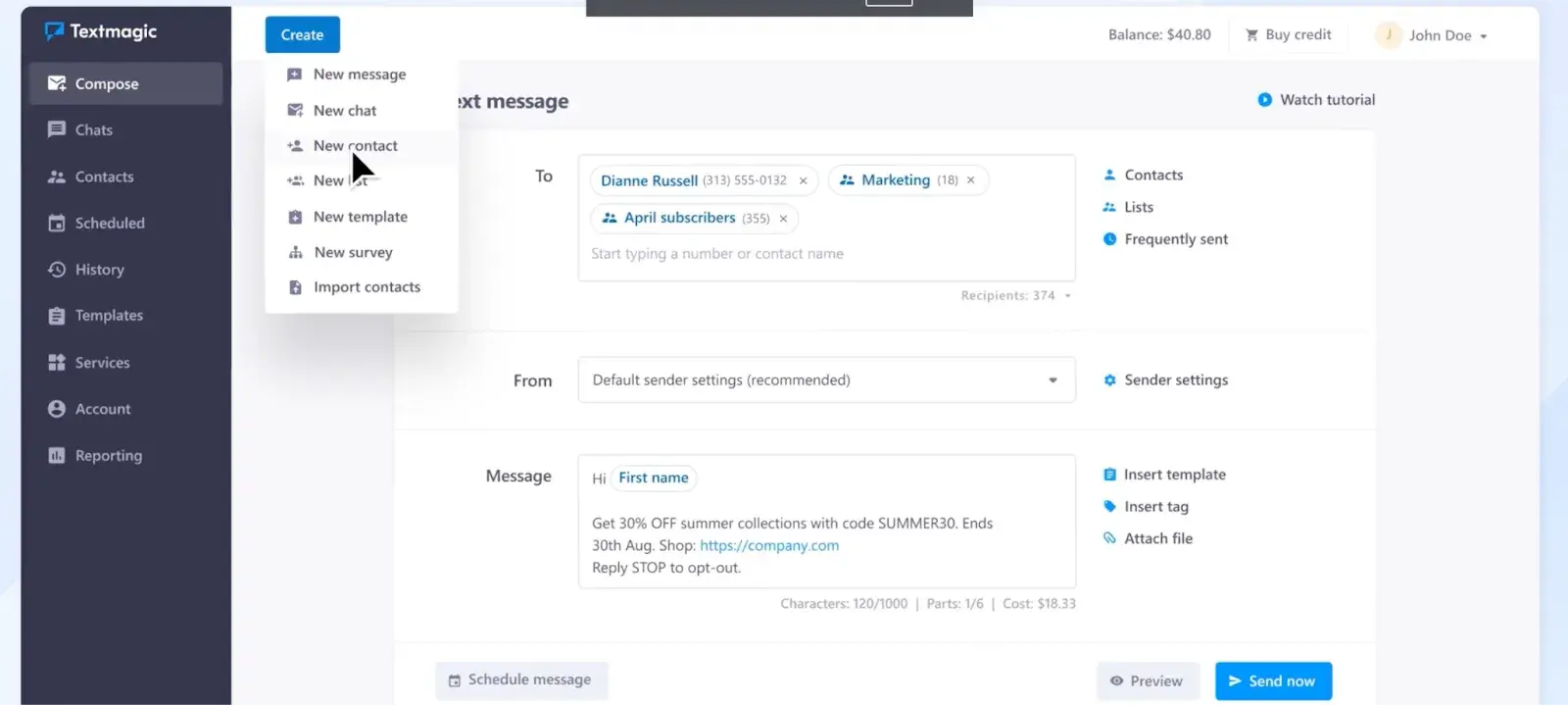
Pricing:
- Pay-as-you-go pricing based on usage.
- SMS rates vary by country, starting at $0.045 per message.
- Free trial with complimentary credits for testing.
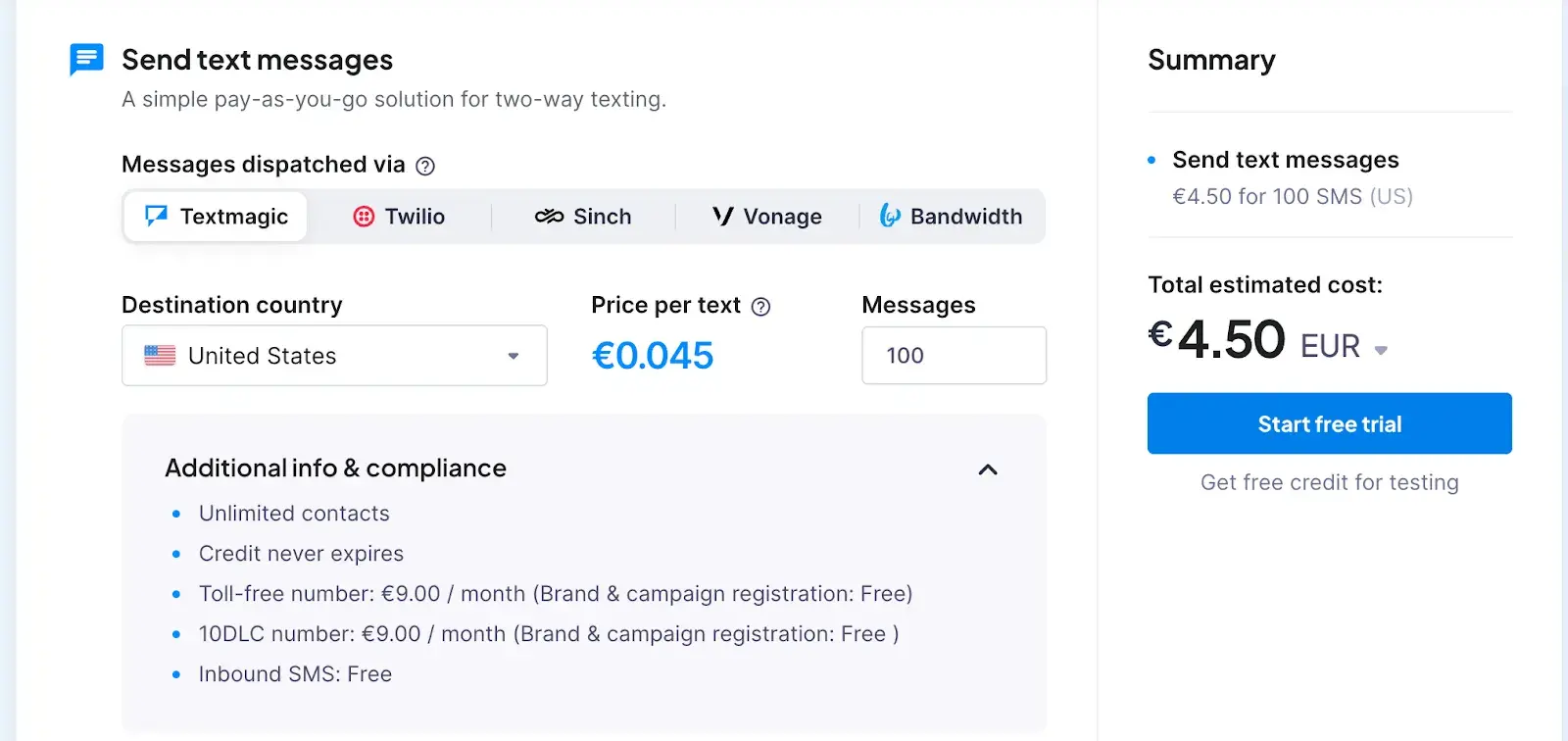
What I like: Simple interface, flexible API, and pay-as-you-go pricing make it great for businesses of all sizes.
What I don’t like: Occasional disruptions with message delivery (especially receiving images) can impact business operations.
4. SimpleTexting
SimpleTexting is an SMS marketing and business texting platform that lets businesses send bulk text messages, automate responses, and engage with customers through two-way texting.
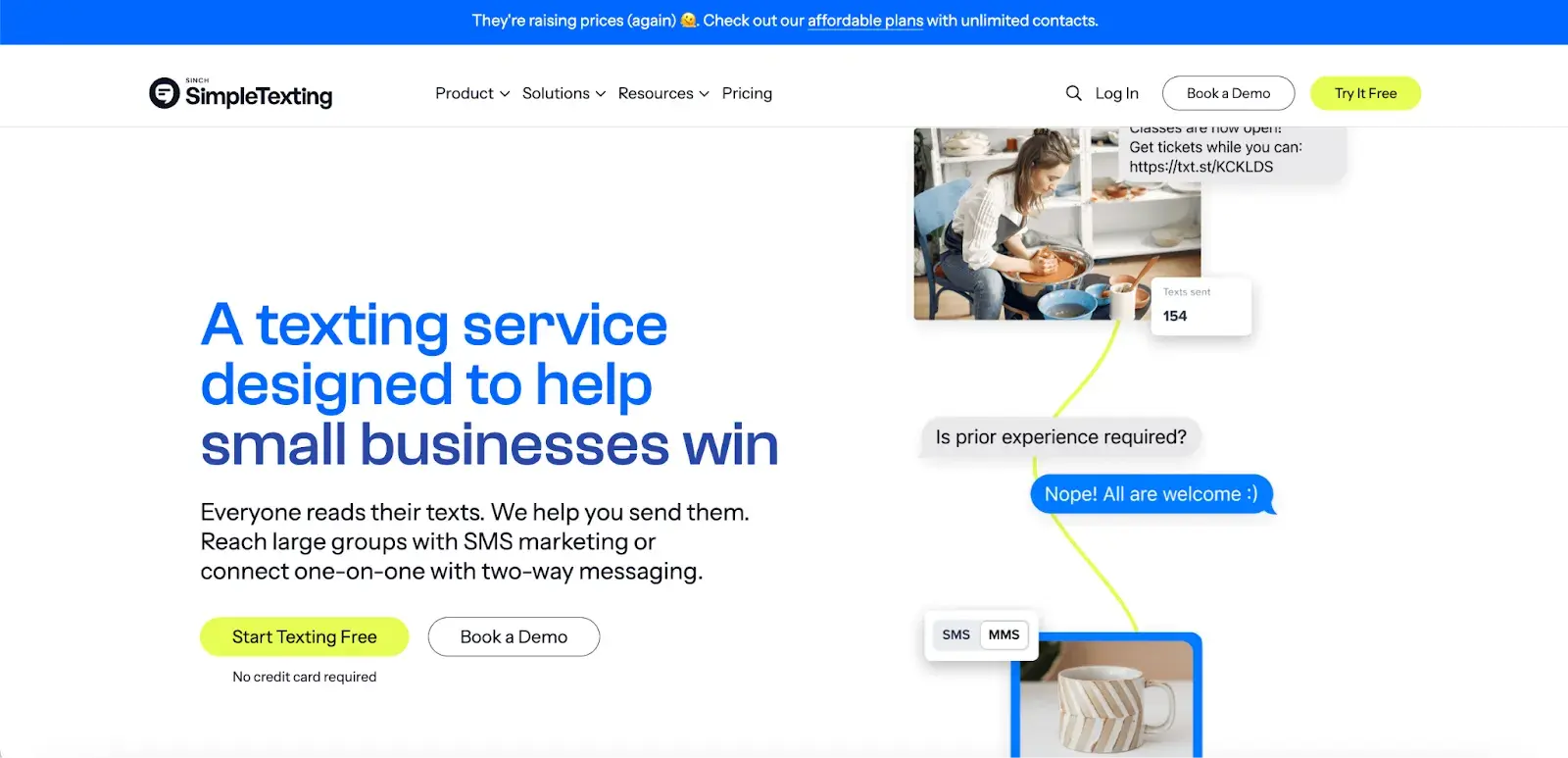
Features:
- Send bulk messages while keeping responses organized.
- Set up automated replies based on keywords.
- Send images, GIFs, and videos for more engaging messages.
- Have real-time conversations with customers.
- Target specific audience groups with personalized texts thanks to segmentation features.
- Connect with Zapier, Mailchimp, HubSpot, and more.
- Track open rates, responses, and overall campaign performance.
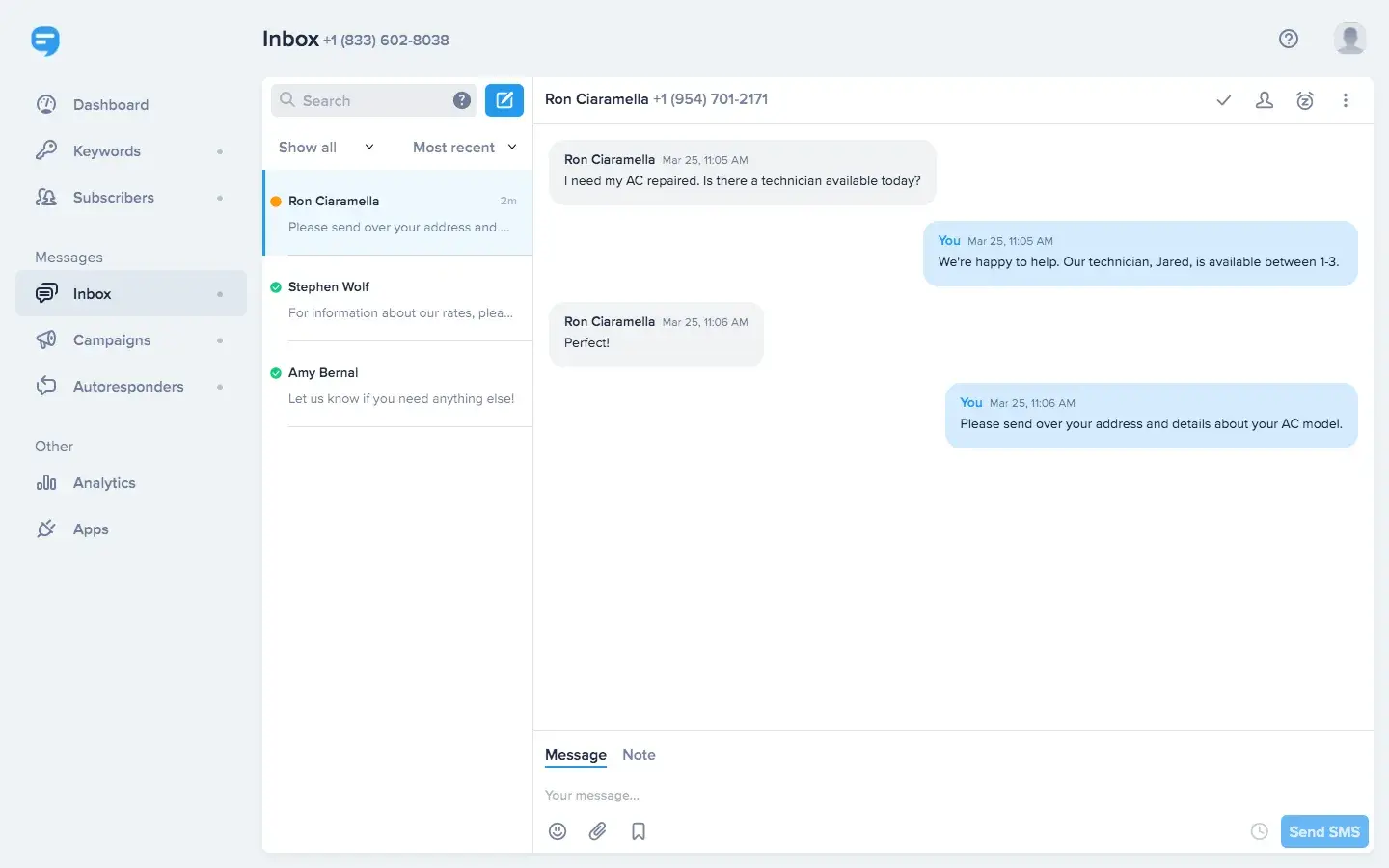
Pricing:
- Starts at $29/month for 500 credits.
- Higher plans scale up based on usage.
What I like: Simple interface, strong automation and segmentation options and MMS support to add cool visual elements to campaigns.
What I don’t like: Some phone numbers, even from internal staff, get marked as “invalid” without a clear reason.
5. EZ Texting
EZ Texting is a cloud-based SMS marketing platform that lets you send bulk texts, automate campaigns, and have two-way conversations with your audience while staying compliant with SMS marketing regulations.
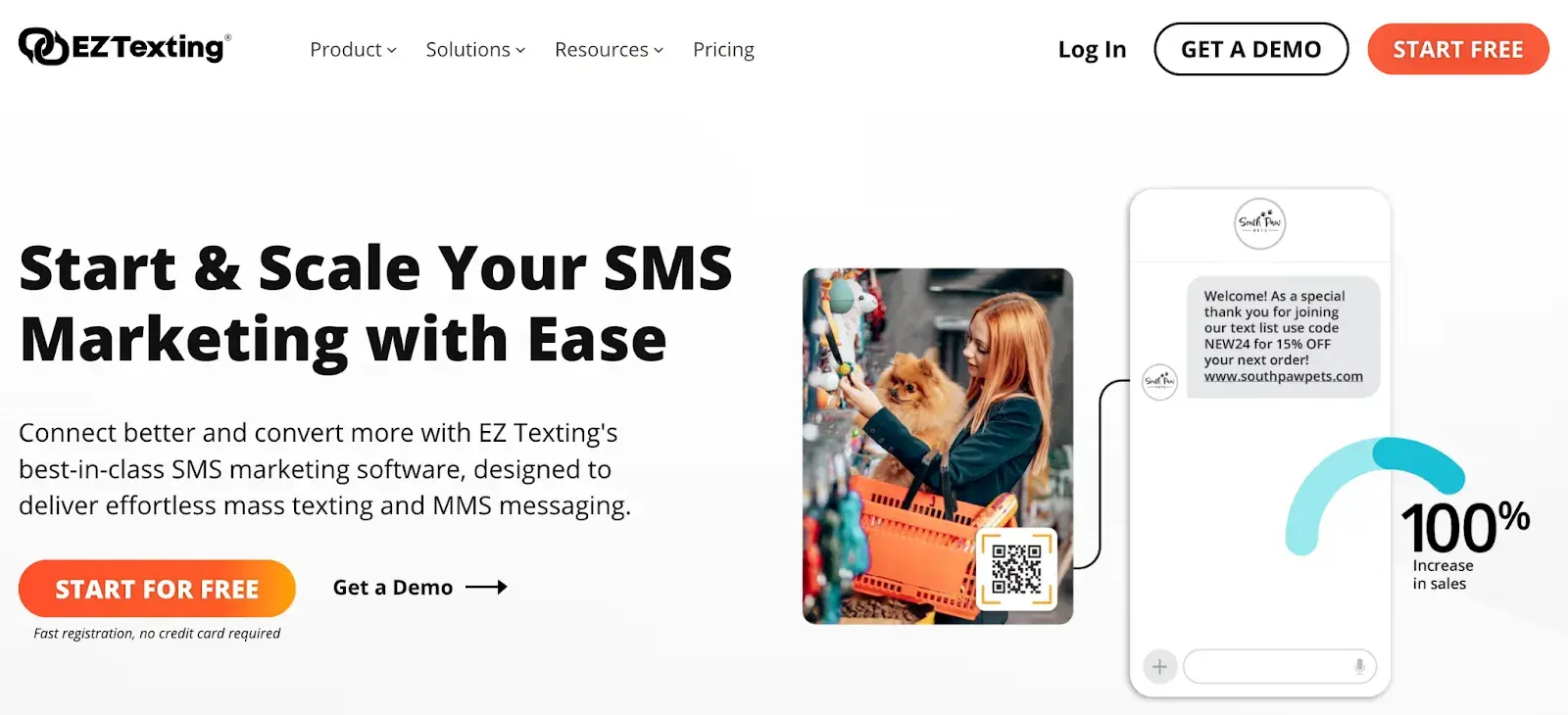
Features:
- Establish credibility with an 800-number and make your brand more memorable with short codes like 858585.
- Organize and personalize your contact list efficiently by importing as many contacts as needed.
- Create groups, apply filters, and use tags for targeted messaging.
- Automatically remove duplicates and invalid numbers.
- Use keyword-based opt-ins for automated responses.
- Create one-click SMS initiation links for customers.
- Redirect messages to another phone or email.
- Integrate with website forms and e-commerce features.
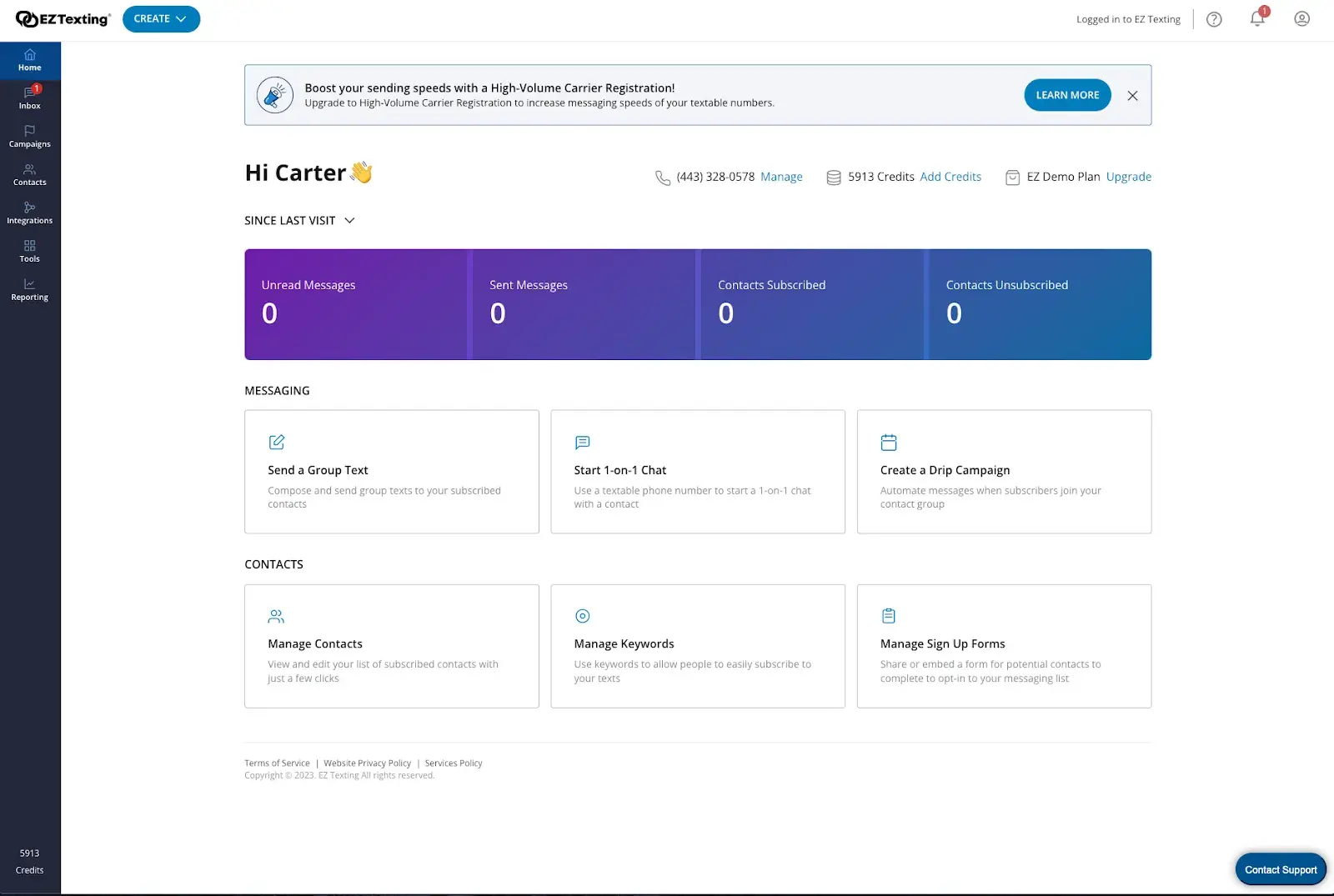
Pricing:
- Starts at $25/month for 500 texts.
- Higher plans are available based on volume and features.
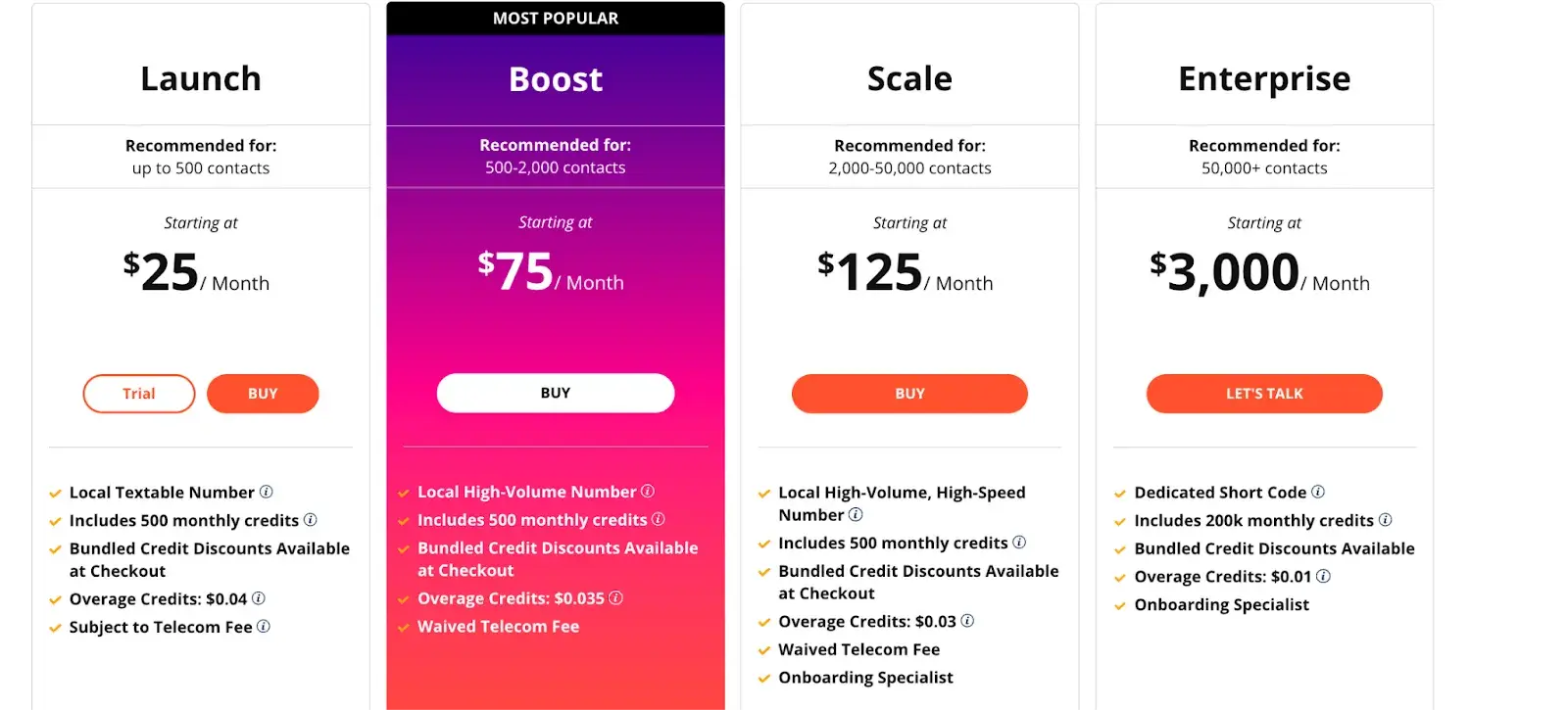
What I like: Straightforward integrations with email marketing platforms and multiple number options, including text-to-landline.
What I don’t like: Paying for undelivered messages.
6. ClickSend
ClickSend is a cloud-based messaging service that lets businesses send and receive text messages globally. It has features like bulk messaging, transactional notifications, and automated SMS/MMS campaigns.
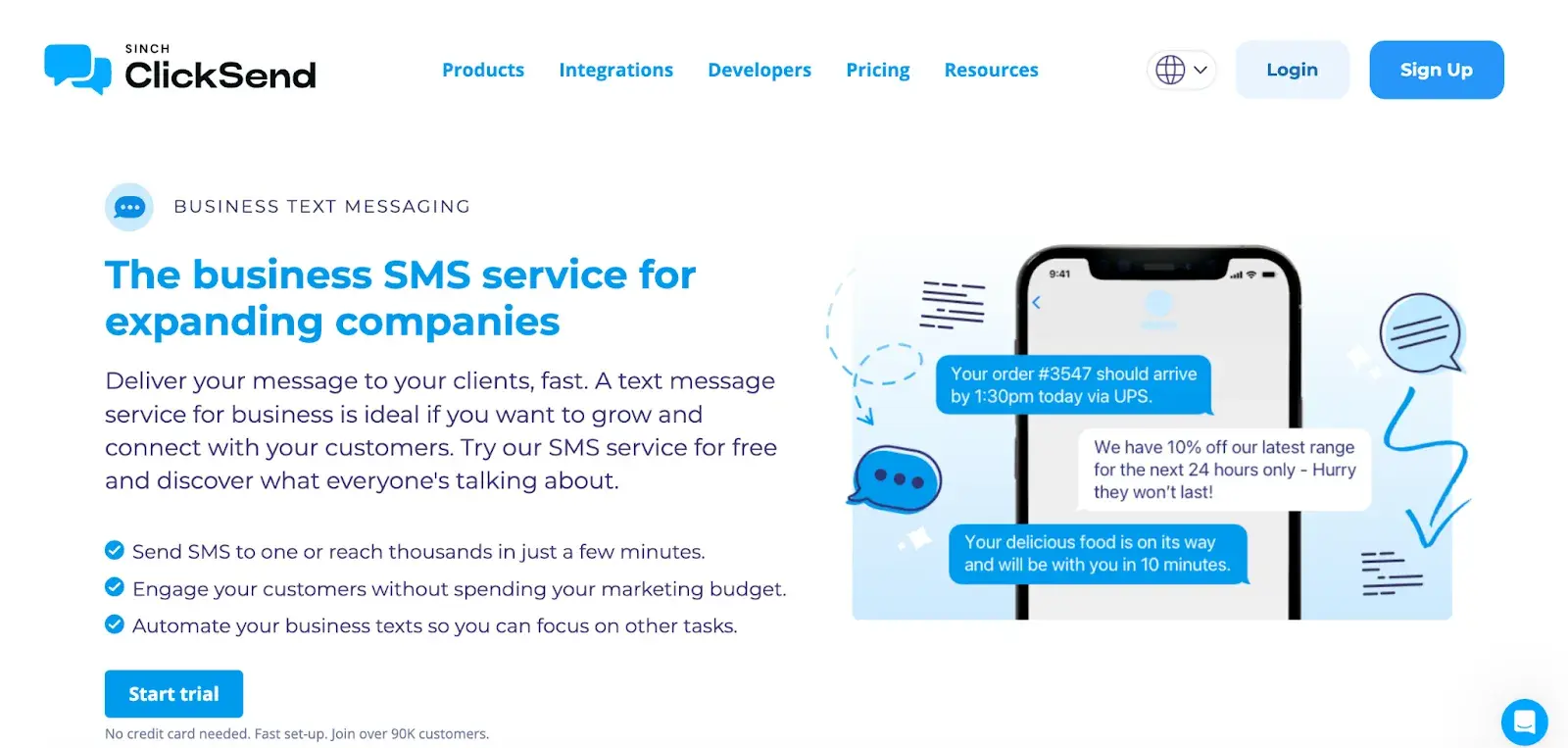
Features:
- Send SMS to individuals or thousands of contacts in minutes with high deliverability.
- Automate text messages for reminders, alerts, and promotions to save time.
- Engage in two-way SMS conversations for customer support and feedback.
- Send bulk SMS directly from your browser with an easy-to-use online dashboard.
- Convert emails into SMS using Outlook or any other email service
- Use API and integrations to send messages through your existing applications.
- Ensure security and compliance with enterprise-grade encryption and a 99.95% uptime guarantee.
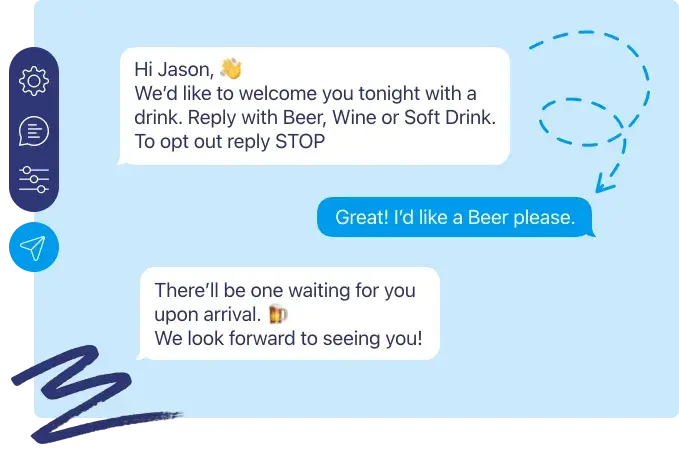
Pricing:
- Pay-as-you-go, starting at $0.0237 per SMS.
- The more contacts you have, the cheaper it gets.
- Pricing also varies by country.
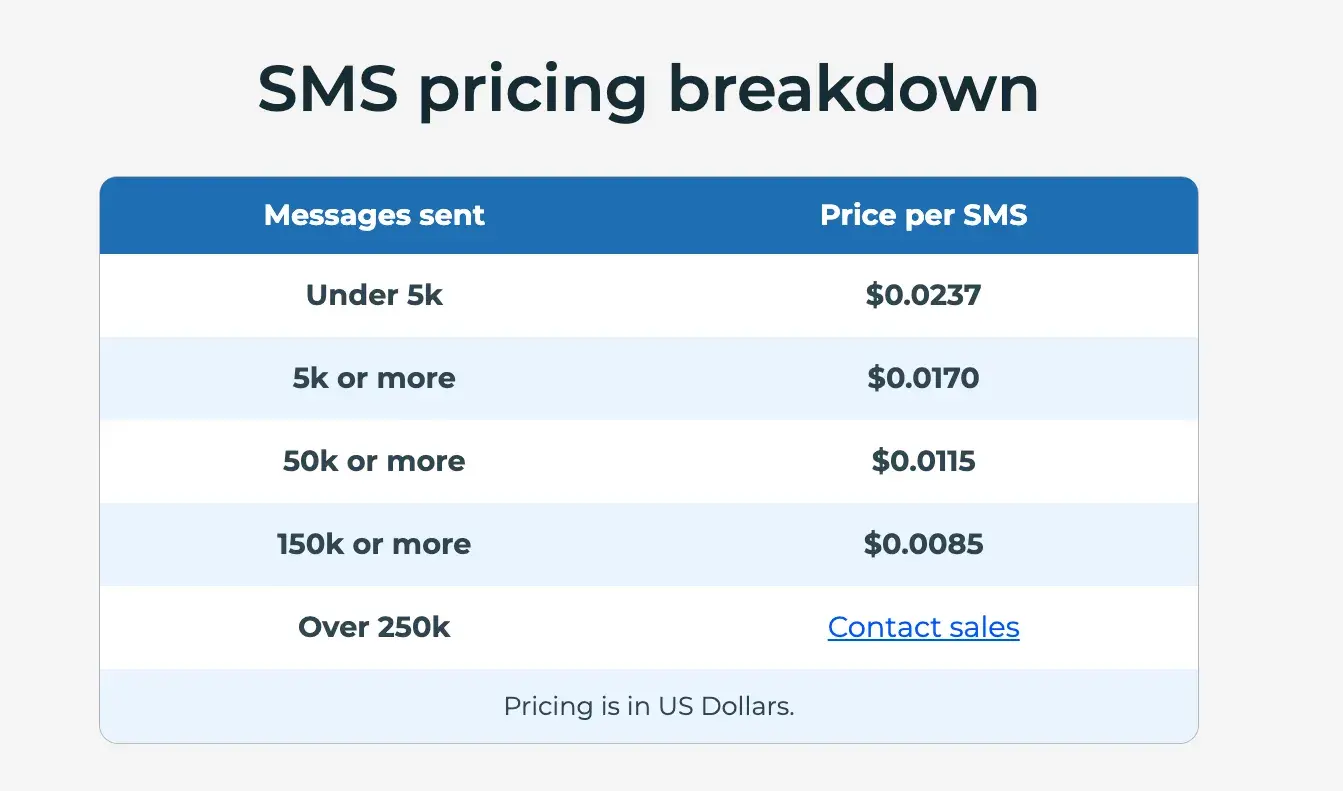
What I like: Flexible automation and integrations with CRMs and email. I also love the bulk messaging option, which is a huge time saver.
What I don’t like: The platform imposes strict character limits, forcing users to either send multiple messages (which costs more) or trim down content unnecessarily.
The best messaging app is the one that fits your business.
At this point, if you ask me which app you should choose, I have to give you the answer most people hate — it depends. But that’s the reality. It all depends on what works best for you. Maybe you need SMS tools (covered earlier) or free options like WhatsApp, Telegram, Viber, or something else.
Either way, in a world where everyone expects instant answers, text messaging marketing apps are a must.
Disclaimer: This blog post is not legal advice for your company to use in complying with EU data privacy laws like the GDPR. Instead, it provides background information to help you better understand the GDPR. This legal information is not the same as legal advice, where an attorney applies the law to your specific circumstances, so we insist that you consult an attorney if you’d like advice on your interpretation of this information or its accuracy. In a nutshell, you may not rely on this as legal advice or as a recommendation of any particular legal understanding.
Editor's note: This post was originally published in May 2018 and has been updated for comprehensiveness.

